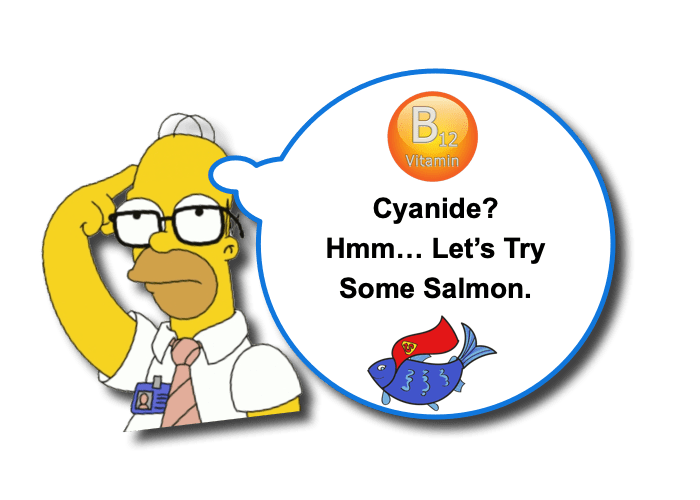Cyanide Poisoning in Children

In the northern hemisphere, it has become cold (sure, last week it was 80 degrees… but now it is snowing) and with the reduction in temperatures come a variety of environmental emergencies (ex, Hypothermia). We have previously discussed an important environmental exposure that often occurs when it gets cold out- Carbon Monoxide Poisoning. When thinking of Carbon Monoxide Poisoning, I naturally think of smoke inhalation and, well, that reminds me of another important consideration. (Interestingly, it also reminds me that Vitamins can be useful (ex, Pyridoxine Deficiency)). Let us take a minute to digest a morsel on Cyanide Poisoning in Children:
Cyanide Poisoning in Children: Basics
Cyanide is a very potent poison!
- Cyanide prevents use of oxygen by cells. [Geller, 2006]
- Inactivates cytochrome oxidase in mitochondria electron transport chain.
- Shifts cells from aerobic to anaerobic metabolism.
- Stops ATP production.
- Increases Lactic Acid production.
- Toxicity can occur in even small doses.
- Treatment should be based on presumptive diagnosis.
- Blood levels are imprecise …
- Depend heavily on timing of exposure and lab draw, route of exposure, and specific cyanide compound.
- Children are more at risk to toxicity (in general), because of:
- Higher respiratory rates (greater inhalation exposure)
- Lower body mass
- Immature metabolic mechanisms
- Higher metabolic demands (typically require great oxygen consumption)
Presentations Vary and are Non-Specific [Geller, 2006]
- Acute poisoning often leads symptoms related to end organs’ inability to generate ATP / being deprived of oxygen.
- Early Symptoms:
- Weakness, Malaise
- Headache, Dizziness, Confusion
- Shortness of Breath
- Later Symptoms:
- Nausea, Vomiting
- Hypotension, Apnea, Arrhythmias
- Seizures, Coma, Death (the classic Toxic conclusion)
- Early Symptoms:
- Severe poisoning can be rapidly fatal and there may not be a progression from “early” to “late” symptoms.
- Exposure to high concentrations of cyanide can lead to death within seconds to minutes.
- Physical exam (and board-style questions) may reveal:
- “Cherry-red” discoloration of the skin (lots of oxygen in the blood).
- Red retinal veins and arteries
- Bitter-Almond odor may be appreciated (from un-metabolized cyanide)
Sources of Acute Cyanide Poisoning in Children [Geller, 2006]
- Inhalation of Smoke
- Major source of exposure for both adults and children.
- Should be considered in any patient with smoke inhalation who is unstable, is acidotic, and/or had loss of consciousness (so don’t just consider carbon monoxide).
- Ingestion of Cyanogenic Compounds
- Young children at greater risk then adults of this exposure.
- Industrial sources may contain cyanide or cyanogenic compounds (like metal cleaning solutions).
- Important example: False-Fingernail Remover (Acetonitrile-containing, NOT acetone-containing variety)
- Acetonitrile is a industrial solvent and may be in cosmetics.
- Its metabolism creates inorganic cyanide.
- Presents in a delayed fashion.
- Don’t confuse Acetone version with Acetonitrile version!!
- Ingestion of Cyanogenic Foods
- When ingested in LARGE quantities or NOT PREPARED correctly.
- Almonds
- Pits of stone fruits (peaches, apricots – pits ground up)
- Lima beans
- Cassava (Tapioca)
- May also be influenced by inadequate diet (ex, Low protein-calorie malnutrition supplemented with lots of cassava).
- When ingested in LARGE quantities or NOT PREPARED correctly.
- Medications / Misc
- Nitroprusside – converted to free cyanide
- Laetrile (promoted as a cancer “cure”) – is the glycoside in apricot pits
Cyanide Poisoning in Children: Management
Our Toxicology crew at Carolinas recently posted a wonderful review of the possible therapies (EMDocs ToxCard) and they stress the importance of being familiar with what your hospital has, since you may not have all antidotes available to you.
Don’t forget the Basics
- Supportive measures [Geller, 2006]
- Reduce any ongoing exposure!
- Give oxygen!
- Resuscitate!
- Manage seizures and arrhythmias as needed.
Antidotes (what makes Toxicology fun!)[Geller, 2006]
- Cyanide Antidote Kit (Amyl Nitrite, Sodium Nitrite, and Sodium Thiosulfate)
- The Nitrite moieties in amyl nitrite and sodium nitrite create methemoglobin.
- Methemoglobin competes to cyanide (freeing the cytochrome oxidase).
- Unfortunately, the methemoglobin can, itself become a problem and even lethal.
- Particularly problematic for smoke inhalation – carboxyhemoglobinemia due to the carbon monoxide poisoning is already stressing the hemoglobin system
- Young children, with persistent fetal hemoglobin, are also at greater risk since fetal hemoglobin is more easily oxidized to methemoglobin and they have a lower activity of methemoglobin reductase.
- Sodium Thiosulfate increases the rate of transformation of cyanide to less toxic thiocyanate.
- Many advocate avoiding the nitrites and using only the Sodium Thiosulfate.
- Pediatric dose: 1-1.65 mL/kg up to 50 mL IV
- Hydroxocobalamin (Cyanokit)
- Precursor to Vitamin B 12
- Detoxifies cyanide by binding it to form cyanocobalamin.
- Not licensed in the US… but… it is in France… so that’s good enough for me.
- Limited data in children.
- Known adverse effects in any age:
- Transient interference with colorimetric clinical tests
- Reddish-brown discoloration of the urine and mucous membranes
- Elevated blood pressure (which may prove to be helpful)
- Acute renal injury (renal function needs to be monitored for several days following administration).
- Pediatric dosing: 70 mg/kg up to 5 g IV
- Combining Therapies
- The Cyanide Antidote Kit is designed to be given in combination, but as was mentioned, the nitrites may be less desirable to use.
- Sodium Thiosulfate + Hydroxocobalamin
- Sodium Thiosulfate can be given initially in the stable patient while awaiting lactate level.
- If lactate is elevated, then Hydroxocobalamin can be given.
Moral of the Morsel
- Where there is Smoke… there is more than Carbon Monoxide. Many of the fabrics and plastics that are burning are sending cyanide into the environment.
- Non-specific symptoms… so Treat before you confirm. This is especially true in the patient who has had loss of consciousness or is very acidotic after smoke inhalation.
- Antidotes are cool! Know what you have and have a plan before you need to order it.

